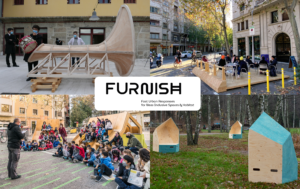FURNISH Fast Urban Responses for New Inclusive Spaces and Habitat (2020)
FURNISH aims to merge the challenge of having more public spaces through ‘tactical urbanism’, which can reconfigure a street expanding the space for pedestrians and leisure, with local digital manufacturing, through the quick and effective deployment of urban elements in a neighborhood.
The FURNISH (Fast Urban Responses for New Inclusive Spaces and Habitat) project will work with the Fab Lab Network, a consortium of municipalities and citizens. Citizens will be involved within the Fab Labs through workshops of 7 pilots in 5 cities where designers (i.e., architects, engineers, planners, etc.) and makers will jointly design, produce and manage the implementation of digitally manufactured Mobile Urban Elements in the respective cities, designed to be temporarily installed in public spaces. Citizens have tested the elements.
Description
FURNISH is a COVID-19 EIT funded project and a living lab with a real-life urban setting awarded July 2020. The overall project is managed by CARNET, The Future Mobility Research Hub (initiated by SEAT, Volkswagen Group Research and UPC), which is an open hub for industrial and academic partners from the areas of automotive and mobility research and innovation. The other partners include: Universitat Politècnica de Catalunya (UPC-BarcelonaTech), Institute for Advanced Architecture of Catalonia (IAAC), ELISAVA Barcelona School of Design and Engineering, Municipality of Milan and AMAT – Milan’s Agency for Mobility Environment and Territory.

CARNET proposed a public call to give prizes to four different institutions in Europe. Apart from these four teams that won – Barcelona (Spain) Milan (Italy), Guimerães (Portugal), Budapest (Hungary) and Espoo (Finland) – there are three more in Barcelona which are done by project partners. These proposed the ideas and won the financing to build the prototypes. During the ideation phase, co-creation processes with workshops took place.
Within the project, a network of fab labs (fabrication laboratories) promotes new architectural ways of working. they are the technical partners that solve technical issues for the living labs. These technical partners have two types of backgrounds – designers (e.g., architects) as well as fabrication/makers (who know how to produce the prototypes with the machines).
The aim is that fab labs digitally fabricate and deploy urban elements for the purpose of adapting temporary public spaces to meet the new challenges and opportunities presented by the COVID-19 crisis. However, it is not only a matter of fabricating and deploying urban elements, but also testing and incorporating the community. Within FURNISH, seven different prototypes are tested with communities. The end users are incorporated in the testing phase by interviewing them, surveying them, and observing how they are using the test environment. Improvements are applied.
The project is based on an open-source philosophy. It will give citizens, industry, and governments access to information about the way these measures could be implemented (at home, or at the public space). By far, the methodology is working, so that it is possible to apply this to other topics. For instance, to make cities safer, more pedestrian-friendly, and other topics which are of interest for cities. The website www.furnish.tech functions as a repository with all the open-source documentation needed to replicate and scale up all prototypes. There is also the vision that cities can ask people who produced them to help them with the criteria, information about the way they could build and scale them.
The end goal of the FURNISH project was to have seven prototypes installed, tested by the users, observed the use and to have a documentation after the tests. Other design teams are asked to assess the elements of the other teams in terms of design and fabrication feasibility. The project has provided a digital open-source documentation – a design booklet, a portfolio for people to replicate. The best outcome of the project is that all these elements can be scaled up not only in Europe, but also all around the world, and that users can make improvements in the design.
References
- https://furnish.tech/
- https://www.eiturbanmobility.eu/tag/furnish/
- https://www.eiturbanmobility.eu/projects/fast-urban-responses-for-new-inclusive-spaces-and-habitat/
- https://www.fablabs.io/
- Interview with Laia Pagès and Ines Aquilué (13/11/2020)
- Figure: AEIOU Prototype (EAUM & I+D+Arq, Guimerães), Open Terrace Prototype (IAAC Team, Barcelona), VORA Prototype (Elisava Team, Barcelona) and Konch Prototype (Not-19, Espoo).